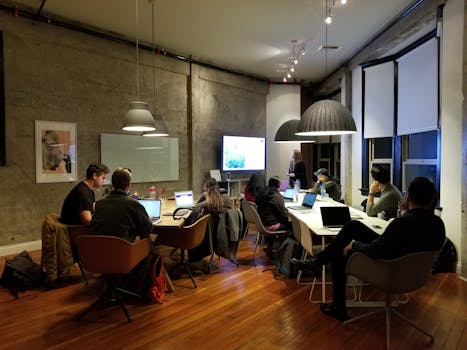Career
Build Your Digital Portfolio: The Ultimate Guide to Showcase Skills
Discover how to build an impressive digital portfolio using free tools. Highlight your skills and boost your visibility with effective SEO strategies.
Advertisement
Creating a digital portfolio has become an essential step for professionals and students alike. It serves as a dynamic showcase of your skills, experiences, and creativity. Today, numerous free tools can help you easily build a compelling digital portfolio without breaking the bank.
Understanding how to create one effectively involves selecting the right platform and organizing your content in a way that highlights your strengths. A well-crafted portfolio can lead to more job opportunities and help you stand out in competitive fields.
This article will guide you through the process of creating a digital portfolio using free tools. You’ll learn about available platforms, tips for organizing content, and how to present your work attractively.
Choosing the Right Platform
The first step in creating your digital portfolio is selecting the right platform. Many free tools offer varying features that cater to different needs. Popular choices include WordPress, Wix, and Behance.
WordPress is versatile and highly customizable. It’s excellent for users wanting more control over layout and functionality. Alternatively, Wix provides an intuitive drag-and-drop interface, making it easy for beginners.
Behance specifically targets creatives such as photographers and graphic designers. It’s ideal for displaying visual work and connecting with other professionals in your field.
While selecting a platform, consider your goals. Are you aiming to attract clients, apply for jobs, or showcase a project? Each platform’s unique features can help meet these goals.
Test different platforms to see which fits your style and comfort level. Each option has tutorials and support forums to assist you along the way, ensuring you start on the right foot.
Organizing Your Content
Once you’ve chosen a platform, the next step is to organize your content. Think about the skills and experiences you want to highlight. A well-structured portfolio tells a story about your professional journey.
Create sections for different types of work, such as projects, case studies, and testimonials. This segmentation allows viewers to navigate your portfolio easily. Consequently, it enhances the overall user experience.
For each project, include descriptions that demonstrate your role and the skills applied. This practice not only showcases your abilities but also provides context for those unfamiliar with your work.
Be selective in what you include. Quality always trumps quantity. Highlight your best work and ensure it aligns with the type of jobs you’re seeking. This targeted approach maximizes the impact of your portfolio.
As you build your portfolio, maintain a consistent style. This could mean uniform fonts, colors, and visuals. Consistency enhances professionalism and makes your portfolio aesthetically pleasing.
Highlighting Your Work Effectively
Highlighting your work effectively is crucial in a digital portfolio. Visual appeal plays a significant role here. Make sure to use high-quality images and engaging visuals.
Employ captions for images to provide context. Captions help explain your thought process and the project’s goals. Additionally, they can describe the tools or software used.
Utilize video samples if applicable. Videos can demonstrate your work in action, proving particularly impactful for fields like marketing or design. They add a dynamic element to your portfolio.
Consider incorporating infographics or charts where relevant. These visual tools can convey information efficiently, making complex data easier to digest for viewers.
Finally, don’t forget to link to any relevant external resources. This may include articles you’ve written, features in publications, or social media profiles. Such links can enhance your credibility and showcase your expertise.
Incorporating Personal Branding
To create a memorable digital portfolio, infuse your personal branding into it. Personal branding differentiates you from others in the field. An established brand draws attention and builds recognition.
Start with a professional logo, which reflects your style or initial. Include this logo across your portfolio consistently to create a cohesive identity. This helps reinforce your brand in viewers’ minds.
Craft an ‘About Me’ section that tells your story. This personal touch can build a connection with potential employers or clients. It also helps convey your passion and commitment to your field.
Your portfolio’s tone should match your personal brand. If your work is creative or playful, your writing style can reflect that. Conversely, a more corporate approach may require a professional tone.
Regularly update your portfolio with new projects and information to keep your brand fresh. This habit shows your growth and adaptability, qualities highly valued in any professional setting.
Utilizing SEO for Increased Visibility
Search Engine Optimization (SEO) is key for making your portfolio discoverable. Even with a great design, without proper optimization, your portfolio might go unnoticed. Start by incorporating relevant keywords into your project descriptions.
Focus on keywords that potential employers might search for. Think about your skills, experiences, and industry terms. Naturally integrate these keywords throughout your text to enhance visibility.
Page titles and meta descriptions also play a crucial role. Make sure to clearly outline what each page contains. This aids not only in SEO but helps users understand what they can expect.
Use alt text for all images. Describing your visuals improves accessibility and can also contribute to your SEO strategy. Alt text allows search engines to understand the content of your images.
Lastly, promote your portfolio on social media and professional networks. When shared properly, it can drive traffic to your portfolio, further enhancing its visibility in search results.
Continuous Improvement and Feedback
Creating a digital portfolio is not a one-time task; it requires continuous improvement. Regularly review and refine your portfolio based on feedback and new skills. This proactive approach will keep your content relevant.
Collect feedback from trusted peers or mentors. A different perspective can help identify strengths and weaknesses in your presentation. Be open to constructive criticism; it often leads to significant improvements.
Keep learning new tools and techniques that can enhance your portfolio. As technology evolves, so do best practices for showcasing work. Stay informed so your portfolio remains cutting-edge.
Set specific goals for updates, such as quarterly reviews. This structured schedule keeps you accountable and ensures that your portfolio doesn’t become stagnant over time.
Remember, your digital portfolio is a reflection of you and your professional journey. Investing time in its evolution demonstrates commitment to your craft and career growth.
Conclusion
Creating a digital portfolio using free tools is an empowering process that showcases your skills creatively and professionally. Choosing the right platform is crucial, as is organizing your content effectively.
Highlighting your work in an appealing manner, incorporating personal branding, and applying SEO strategies will significantly enhance your portfolio’s visibility. Regular updates and seeking feedback ensure your portfolio evolves over time.
Ultimately, a well-crafted digital portfolio can be your ticket to new opportunities. Embrace the journey of building it and let your unique identity shine through.





